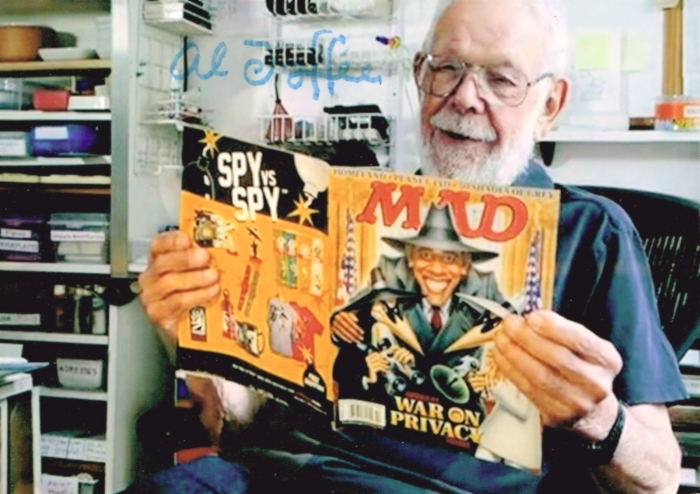
The exhibit at the Zarasai Regional History Museum contains illustrations by Al Jaffee included in Mary-Lou Weisman’s book “Al Jaffee’s Mad Life: A Biography.” In an interview with his biographer Al Jaffee called himself a reverse immigrant: when most people were leaving Lithuania for the USA, he went in the opposite direction. Savannah in the 1920s had electricity, inside toilets, asphalt streets, movie theaters and newspapers with daily comic strips. Zarasai, however, hadn’t changed much since the end of the 19th century. Al was the odd man out among the local children in Zarasai, where multilingualism was the rule and people spoke Lithuanian, Russian, Polish and Yiddish. He did manage to adapt to live there, though. The children invented games as children do and the entire town was their playground. The small town became the petri dish where Al and his brother Harry developed their creative talents. Even now Al says the years of his childhood he spent in Zarasai are some of the happiest years of his life.
Al’s popularity has grown continuously. In 1955 he began drawing for Mad magazine in New York City. He’s still drawing now. He lives with his wife Joyce in Manhattan.
You’re invited to visit the exhibit weekdays from 10:00 A.M. to 4:00 P.M. (other times are available as well if prior notice is given).
About the Collection
This collection of illustrations are works by Al Jaffee. They are included in Mary-Lou Weisman’s biography, first published by Harper Collins. The art work is the intellectual property of Al Jaffee. Jaffee and Harper Collins both gave hearty consent to using reproductions of Jaffee’s art work used in the book for the exhibit at the Zarasai Regional History Museum. Reproductions were produced by the Neostandartas company in Vilnius. Remembering Litvaks, Inc., a US company, paid for the work. Aldona and Phillip Shapiro made the bilingual inscriptions in Lithuanian and English under the illustrations at the exhibit.
Al Jaffee’s Life
Jaffee was born in Savannah, Georgia, in 1921. His real first name is Abraham. He took on the nickname Allan while serving in World War II and the nickname stuck as Al.
His mother Mildred Gordon-Jaffee, whose real first name was Mikhle, was born in Zarasai. In 1913 she travelled by ship from Liepaja to New York. Al’s father Morris Jaffee was probably also born in Zarasai. Morris came to New York in 1905. He served in the US military in World War I, and was taken prisoner. His wartime experience imparted in him a lifelong hatred of violence.
Morris and Mildred married in 1919 and in 1920 moved to Savannah. Al was born in 1921, followed by three more boys. In 1927 Mildred took her four sons to her native Zarasai in Lithuania.
Morris didn’t raise a fuss and let her take the boys. Mildred and sons went to New York, then on to Berlin, Memel and Kaunas, and took a bus from Kaunas to Zarasai. After a year Morris managed to talk Mildred into returning to the US with the children. She did, but in 1929 they all went back to Zarasai again.
In his interview with Weisman, Al called himself a reverse immigrant. When most people were going the opposite direction, Al went from the USA to Lithuania. Savannah in the 1920s had electricity, inside toilets, asphalt streets, movie theaters and newspapers with daily comic strips. Zarasai, however, hadn’t changed much since the end of the 19th century.
Al was the odd man out among the local children in Zarasai, where multilingualism was the rule and people spoke Lithuanian, Russian, Polish and Yiddish. He did manage to adapt to live there, though. The children invented games as children do and the entire town was their playground. The small town became the petri dish where Al and his brother Harry developed their creative talents. Even now Al says the years of his childhood he spent in Zarasai are some of the happiest years of his life.
In 1932 Al, his mother and his brothers moved to the Jewish neighborhood of Slabodka in Kaunas. Morris organized a rescue mission when Hitler came to power in 1933. Mildred let three sons return to the US. Morris, Al, Harry and Bernard boarded a train in Kaunas and it was the last time they ever saw Mildred. They made a detour around Nazi Germany via Goteburg in Sweden on their way back to New York.
Back in the USA Al’s love of drawing received important recognition. In September of 1935 he won a drawing contest which opened doors for him, namely the doors of the Fiorella H. La Guardia Art and Music High School.
Al’s grandfather Haim died in December of 1933. Mildred and her youngest son Israel David went back to Zarasai where they spent their remaining years teaching English. When Nazi Germany and the USSR attacked Poland in September, 1939, Morris did everything he could think of to get his son back home. Somehow he did raise funds to rescue David. David reached Antwerp and sailed for New York, arriving in April of 1940. One month later Nazi Germany invaded and occupied Belgium.
Mildred stayed in Zarasai. It is believed she was murdered there on June 26, 1941, or August 26, 1941, when most of the Jews of the regions were murdered in the Krakynė forest.

